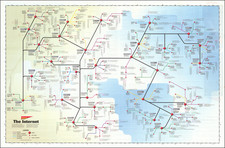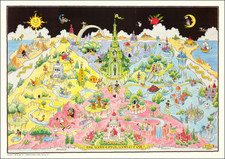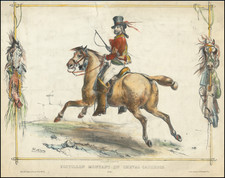Dedicated to Benjamin Franklin -- A Landmark Work on Visualizing Information
First edition of Joseph Priestly's rare broadside chart of history, dedicated to his friend, Benjamin Franklin.
Priestly's chart is generally regarded as the most influential time line of the 18th Century. Offered here in the exceedingly rare first edition.
Joseph Priestley, FRS (1733 - 1804) was an 18th-century English theologian, natural philosopher, chemist, educator, and political theorist who published over 150 works. He is generally credited with the discovery of oxygen. Among his major accomplishments were:
- the invention of soda water
- writings on electricity
- discovery of several "airs" (gases), the most famous being what Priestley dubbed "dephlogisticated air" (oxygen).
Priestley believed that a proper understanding of the natural world would promote human progress and eventually bring about the Christian Millennium. Priestley, who strongly believed in the free and open exchange of ideas, advocated toleration and equal rights for religious dissenters, which also led him to help found Unitarianism in England. The controversial nature of Priestley's publications combined with his outspoken support of the French Revolution aroused public and governmental suspicion, and Priestley was eventually forced to flee, in 1791, first to London, and then to the United States, after a mob burned down his home and church. He spent the last ten years of his life living in Northumberland County, Pennsylvania.
Priestley also made significant contributions to pedagogy, including the publication of a seminal work on English grammar, books on history, and he prepared some of the most influential early timelines.
Priestley considered the study of history to be essential for worldly success as well as religious growth. He wrote histories of science and Christianity in an effort to reveal the progress of humanity and, paradoxically, the loss of a pure, "primitive Christianity".
Priestley believed this chart would "impress" upon students "a just image of the rise, progress, extent, duration, and contemporary state of all the considerable empires that have ever existed in the world". Priestley argued that the education of the young should anticipate their future practical needs. He recommended modern languages instead of classical languages and modern rather than ancient history. Priestley's lectures on history were particularly revolutionary; he narrated a providentialist and naturalist account of history, arguing that the study of history furthered the comprehension of God's natural laws. Furthermore, his millennial perspective was closely tied to his optimism regarding scientific progress and the improvement of humanity. He believed that each age would improve upon the previous and that the study of history allowed people to perceive and to advance this progress.
Since the study of history was a moral imperative for Priestley, he also promoted the education of middle-class women. Priestley designed two Charts to serve as visual study aids for his Lectures, this New Chart of History and his Chart of Biography, which was published in 1765. These charts have been described as the most influential timelines published in the 18th century.










![Idea dell' universo [Two-Sheet Cosmographical Chart]](https://storage.googleapis.com/raremaps/img/small/90009.jpg)
![[ Plasterers Company -- Certification of Master Plasterer Edward Evans ]](https://storage.googleapis.com/raremaps/img/small/97322.jpg)
![[ Passport of Lemuel B. Norton ]](https://storage.googleapis.com/raremaps/img/small/48456.jpg)

